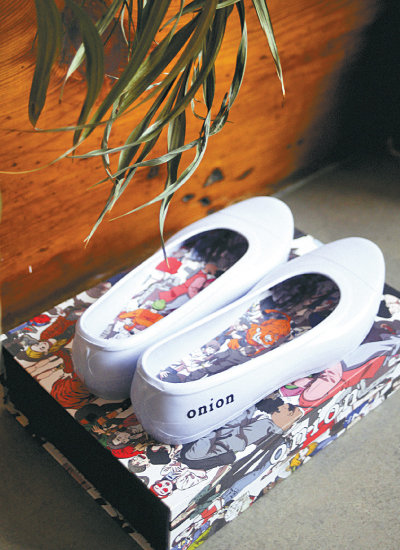Onion puts a hip spin on traditional Korean gomusin

Onion’s new gomusin (traditional rubber shoes) that were created as part of an artist collaboration project with illustrator Kim Jung-youn. [ONION]
Recently, however, gomusin have been spotted on the feet of foreign visitors to Korea, who were paying a visit to Onion’s Anguk branch, which established itself inside an old hanok building in central Seoul.
Since visitors can take off their shoes to sit down on the daecheong-maru (a raised wooden floor) to look out at the courtyard at Onion Anguk, the cafe placed some gomusin there for visitors’ convenience. Foreign visitors, who make up more than 60 percent of sales at Onion Anguk, found the gomusin so interesting that many took pictures of themselves wearing them and posted the photos on social media.
Noticing that the photos were going viral, Yu Zu-hyung, CEO of Onion, which has three branches in Seoul, decided to help revive gomusin, since retro fashion is back in vogue.
By collaborating with popular illustrator Kim Jung-youn, who is also widely known as an avid shoe collector, Onion launched its own version of gomusin, just in time for the Lunar New Year.
“In Korea, Emperor Sunjong [1874-1926] of the Joseon Dynasty [1392-1910] is said to be the first person who wore gomusin,” said Yu. “Back in the 1920s, rubber was an expensive material. Until then, shoes were mostly handmade using straw for commoners or leather for the nobles. Therefore, the introduction of gomusin that is not only durable in bad weather but that can also be mass produced was a knockout innovation.”
“Gomusin was produced by taking after the design of the leather shoes that the nobles wore, and it had been ‘the shoes of the people’ for the next 50 years,” Yu continued. “However, the demand gradually decreased after the 1960s and they are seen as the shoes of history.”
Yu says that this history and tradition of Korea amazed him so much that he thought he “might as well share this with Koreans and foreigners visiting Korea” since they are already trying on gomusin at the cafe and taking selfies.
Moreover, since many projects Onion has engaged in have been about reinterpreting the old using new materials, Yu thought it will be a great opportunity to have a go at reinterpreting gomusin in the trendiest way so that it could become a new fashion item.
That is why Yu asked Kim for help.
“Kim’s works show his own interpretations of culture using his unique colors and a touch of wit,” explained Yu. “Kim managed to show a scene of Korea that has once again fallen deeply in love with our rubber shoes through his uniquely detailed illustration. This is the gomusin of cafe Onion.”
Kim’s illustration inside the sole of the gomusin features witty images of famous characters who represent Korea wearing gomusin, such as Korean soccer player Son Heung-min and the K-pop sensation BTS.
“It’s quite interesting to spot such characters as you wear them, or simply display them as fashion items like many people do with limited edition sneakers,” said Yu.
“It’s from the past, but it doesn’t have to be outdated. We hope to see gomusin being worn in the hippest way.”
Onion gomusin only come in two sizes, small and large, and currently it can be purchased at all three Onion stores or via sending a direct message to Onion’s official Instagram (@cafe.onion). The shoes cost 48,000 won ($41) a pair.
BY YIM SEUNG-HYE [sharon@joongang.co.kr]










with the Korea JoongAng Daily
To write comments, please log in to one of the accounts.
Standards Board Policy (0/250자)